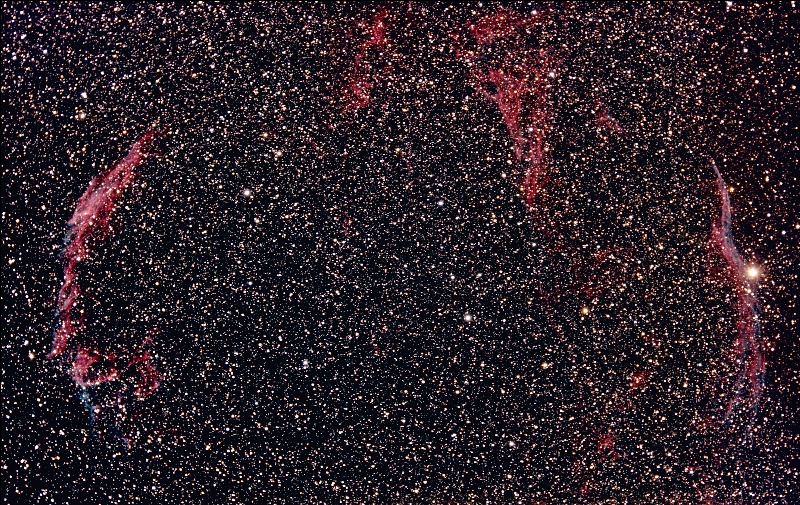 |
The Veil Nebula Complex in Cygnus
 |
Copyright 2004 Hap Griffin
The Veil Nebula Complex is the aftermath of a colossal explosion of a star (a Supernova) 5000 to 10,000 years ago. Here, we see the shredded remains of the star expanding outward from its previous location. During its lifetime, a star synthesizes through nuclear fusion all of the elements heavier than hydrogen. Once the star begins to create lead, the outward radiation pressure from the nuclear reaction in the core is suddenly reduced. Gravity takes over quickly to cause the star's outer layers to collapse, causing the core to explode in one of the most violent reactions in the Universe. The energy of the Supernova causes elements heavier than lead to be created in the death throws of the star. These heavier elements are scattered back into space to be assimilated into future generations of stars and planets. Thus, all of the elements more complex than hydrogen are created in Supernovae. We ourselves and all with which we are familiar are made of these remnants. In this photograph, we see the seeding of the Universe...the ultimate recycling of star material.
The various parts of the Veil Nebula complex have been given separate identifications. The brighter eastern section on the left is known as NGC 6992/95. The western section on the right is listed as NGC 6960. At the top middle is Pickering's Triangular Wisp and to its left is NGC 6974/79.
The Veil Nebula
lies at a distance of 1400 light years.
Date/Location:
November 6, 2004 Griffin/Hunter
Observatory Bethune, SC
Instrument: Canon 300D (modified) Digital SLR through Orion ED80 w/ Meade
.63 Focal Reducer piggybacked on LX-200
Focal Ratio: Approx. f4.5
Guiding: Auto through LX-200 w/ SBIG ST-237
Conditions: Visually clear
Weather: 45 F
Exposure: 65 minutes @ ISO 800 (13 x 5 min exposures) calibrated with flat
frame and Master Dark frame (average of 3 darks)
Filters: None
Processing: Focused and captured with DSLRFocus.
RAW to TIFF conversion, frame calibrations, alignment, Digital Development,
Richardson_lucy deconvolution, scaling and JPEG conversion with ImagesPlus.